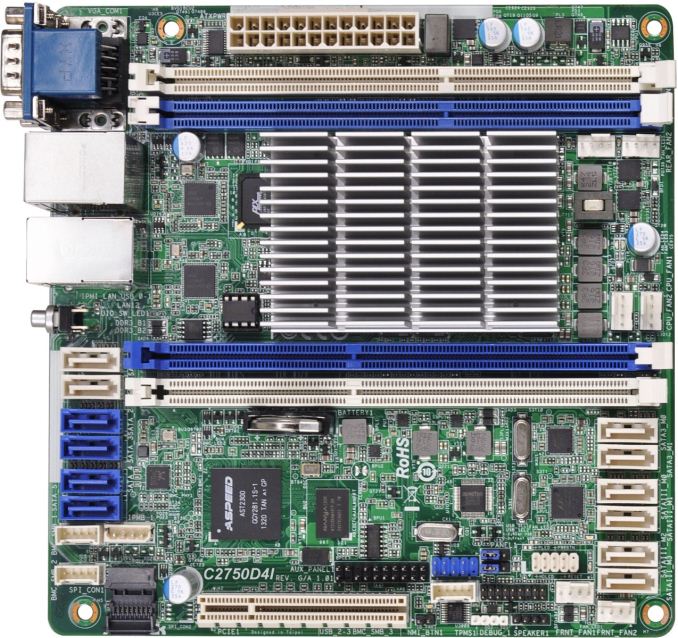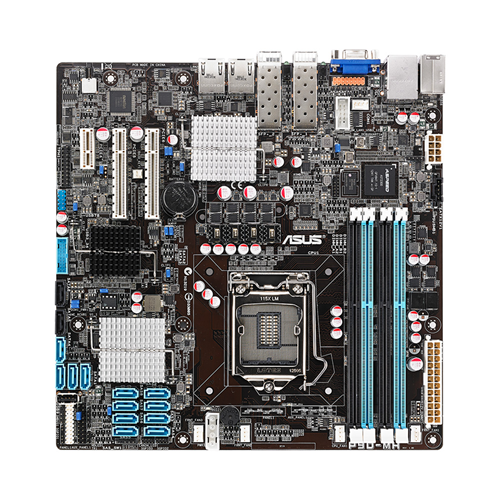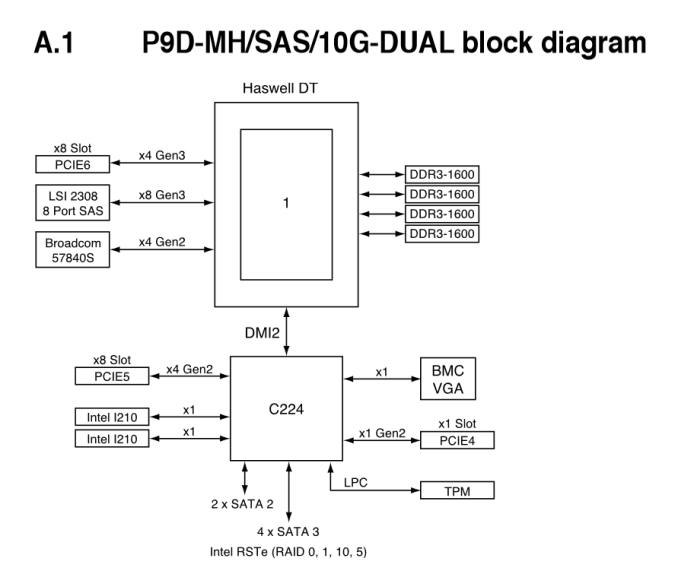X-Gene 1, Atom C2000 and Xeon E3: Exploring the Scale-Out Server World
by Johan De Gelas on March 9, 2015 2:00 PM ESTLow-End Server Building Blocks
Micro and low-end servers come in all shapes and forms. Ideally, we would gather them all in our labs and make a performance per watt comparison, taking the features that make management easier into account. The reality is that while lots of servers enter our lab, many of the vendors cannot be easily convinced to ship heavy and expensive server chassis with a few tens of nodes.
In AnandTech tradition, we decided to take a look at the component level instead. By testing simple motherboard/CPU/RAM setups and then combining those measurements with the ones we get from a full blown server, we can get a more complete picture. A simple motherboard/CPU/RAM setup allows us the lowest power numbers possible, and a full blown server measurement tells us how much the more reliable cooling of a full blown server chassis adds.
ASRock's C2750D4I
The mini-ITX ASRock C2750D4I has the Atom "Avoton" C2750 SoC (2.4GHz, eight Silvermont cores) on board. If you are interested in using this board at home, Ian reviewed it in great detail. I'll focus on the server side of this board and use it to find out how well the C2750 stacks up as a server SoC.
Contrary to the Xeon E3, 16GB DIMMs are supported. The dual-channel, four DIMM slot configuration allows you to use up to 64GB. This board is clearly targeted at the NAS market, as ASRock not only made use of the six built-in SATA ports (2x SATA 6G, 4x SATA 3G) of the Atom SoC but also added a Marvell SE9172 (2x SATA 6G) and a Marvell SE9230 (4x SATA 6G) controller. Furthermore, ASRock soldered two Intel i210 gigabit chips and an AST2300 to the board. However, the Atom "Avoton" integrated 16 PCIe lanes only support four PCIe devices. The PCIe x8 slot already needs eight of them and the Marvel SE9230 takes another two PCIe lanes, so the ASRock board needs a PLX 8608 PCIEe switch.
The end result is that the ASRock C2750 board consumes more energy at idle than a simpler micro server board would. We could not get under 26W, and with four DIMMs 31W was needed. That is quite high, as Supermicro and several independent reviews report that the Supermicro A1SAM-2750F needs about 17W in the same configurations.
ASUS P9D-MH
The micro-ATX ASUS P9D-MH is a feature rich Xeon E3 based board. ASUS targets cloud computing, big data, and other network intensive applications. The main distinguishing feature is of course the dual 10 Gigabit SFP+ connectors of the Broadcom 57840S controller.
The C224 chipset provides two SATA 3G ports and four SATA 6G ports. ASUS added the LSI 2308 controller to offer eight SAS ports. The SAS drives can be configured to run in a RAID 0/1/10 setup.
The Xeon E3-1200v3 has 16 integrated PCIe 3.0 lanes. Eight of them are used by the LSI 2308 SAS controller, and the 10 Gigabit Ethernet controller gets four fast lanes to the CPU. That leaves four PCIe 3.0 lanes for a mechanical x8 PCIe slot.
The second x8 PCIe slot gets four PCIe 2.0 slots and connects to the C224 chipset. The remaining PCIe 2.0 lanes are used by the BMC, the PCIe x1 slot, and the dual gigabit Ethernet controller.
Of course, all these features come with a price. With the efficient Xeon E3-1230L (25W TDP) and four 8GB DIMMs, the board consumes 41W at idle.













47 Comments
View All Comments
gdansk - Monday, March 9, 2015 - link
xgene is not looking so great. Even if it is 50% more efficient as they promise they'll still be behind Atom.Samus - Monday, March 9, 2015 - link
HP Moonshot chassis are still *drool*Krysto - Monday, March 9, 2015 - link
The main problem with the non-Intel systems is not only that they use older processes compared to Intel, but that they use older processes even compared to the rest of the non-Intel chip industry. AMD is typically always behind 1 process node among non-Intel chip makers. If they'd at least use the cutting edge processes as they become available from non-Intel processes, maybe they'd stand a chance, especially now that the gap in process technologies is shrinking.Samus - Monday, March 9, 2015 - link
AMD simply isn't as bad as people continually make them out to be. Yes, they're "behind" Intel but it's all in the approach. We are talking about two engineering houses that share nothing in common but a cross licensing agreement. AMD has very competitive CPU's to Intel's i5's for nearly half the price, but yes, they use more power (at times 1/3 more.)But facts are facts: AMD is the second high-tech CPU manufacture in the world. Not Qualcomm, not Samsung. It's pretty obvious AMD engineering talent spreads more diversity than anyone other than Intel, and potentially superior to Intel on GPU design (although this has obviously been shifting over the years as Intel hires more "GPU talent.")
AMD in servers is a hard pill to swallow though. If purchasing based on price alone, it can be a compelling alternative, but for rack space or low-energy computing?
Taneli - Tuesday, March 10, 2015 - link
AMD doesn't even make it in top 10 semiconductor companies in sales. Qualcomm is three, Samsung semicondutors six and Intel almost ten times the size of AMD.Outside of the gaming consoles they are being completely overrun by competition.
owan - Tuesday, March 10, 2015 - link
I'm sorry, at one point I was an AMD fanboy, back when they actually deserved it based on their products, but you just sound like an apologist. Facts are the facts, FX processors aren't competitive with i5's in performance or power or performance/$ because they get smacked so hard they can't be cheap enough to make up for it. Their CPU designs are woefully out of date, their APU's are bandwidth starved and use way too much power to be useful in the one place they'd be great (mobile), and their lagging process tech means theres not much better coming on the horizon. I don't want to see them go, but at the rate ARM is eating up general computing share, it won't be long before AMD becomes completely irrelevant. It will be Intel vs. ARM and AMD will be an afterthought.xenol - Wednesday, March 11, 2015 - link
Qualcomm is used in pretty much used in most cell phones in the US to the point you'd think Qualcomm is the only SoC manufacturer. I'm pretty sure that's also how it looks in most of the other markets as Korea. Plus even if their SoCs aren't being used, they're modems are heavily used.If anything, Qualcomm is bigger than AMD. Or rather, Qualcomm is the Intel of the SoC market.
xenol - Wednesday, March 11, 2015 - link
[Response to myself since I can't edit]Qualcomm's next major competitor is Apple. But that's about it.
Also I meant to say other markets except Korea.
CajunArson - Monday, March 9, 2015 - link
Bear in mind that the Atom parts were commercially available in 2013, so they are by no means brand-new technology and the 14nm Atom upgrades will definitely help power efficiency even if raw performance doesn't jump a whole lot.Anandtech is also a bit behind the curve because Intel is about to release Xeon-D (8 Broadwell cores and integrated I/O in a 45 watt TDP, or lower), which is designed for exactly this type of workload and is going to massively improve performance in the low-power envelope sphere:
http://techreport.com/review/27928/intel-xeon-d-br...
SarahKerrigan - Monday, March 9, 2015 - link
14nm server Atom isn't coming.http://www.eetimes.com/document.asp?doc_id=1325955
"Atom will become a consumer only SoC."